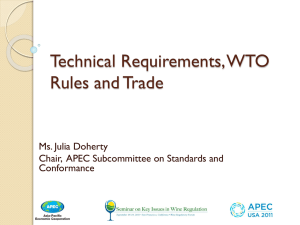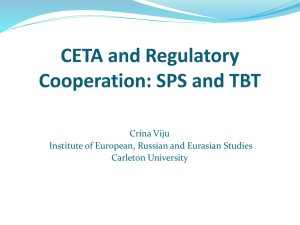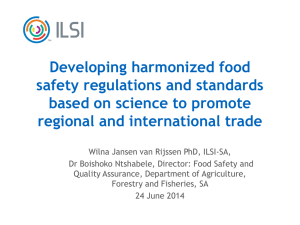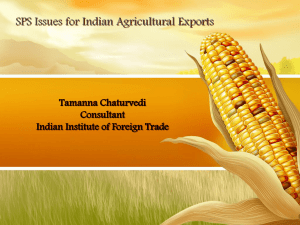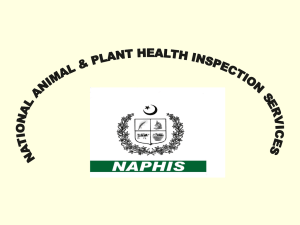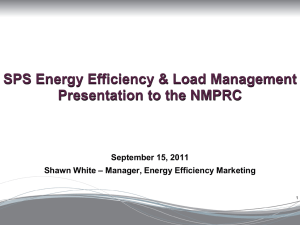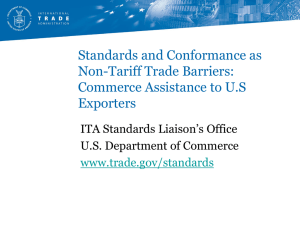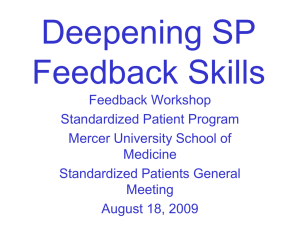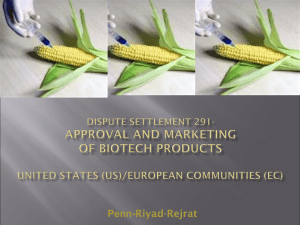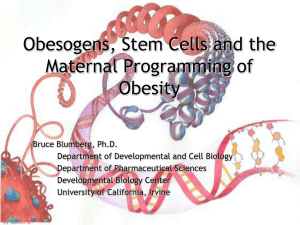Irina Kireeva
advertisement
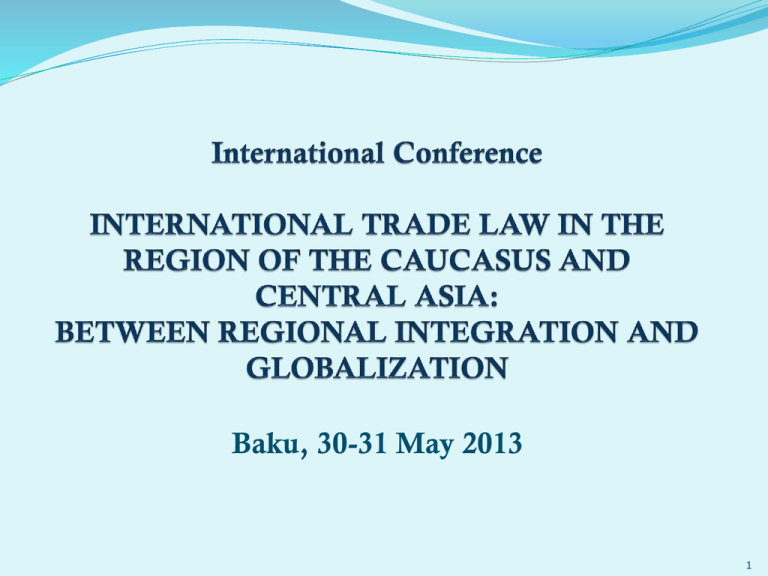
Baku, 30-31 May 2013 1 2 Major difficulties of some WTO Members in complying with the SPS and TBT Agreements Objective of the legal research and assessment The objective of the legal research and assessment was to review the sanitary and technical regulatory frameworks of the Russian Federation, Kazakhstan and Azerbaijan (focusing on norms and requirements related to food and product safety) and indicate major shortcomings and difficulties in complying with the WTO Agreements as well as to provide recommendations in relation to harmonisation with international norms and standards. 3 Harmonization of standards, regulations and laws with international requirements are vital arguments for further accession of Azerbaijan and Kazakhstan to the WTO. Although Russia has recently joined the WTO, issues of SPS and TBT compliance are also of the importance for increasing competitiveness and quality of traded goods. 4 How to ensure food safety and consumer protection in accordance with the national legislation? What is harmonisation? Harmonisation of national legislation in line with international standards is a process by which a state transplants identical regulatory principles or adopts the same laws, regulations or standards as those internationally agreed. 5 What is Food Safety? Assurance that food will not cause harm to the consumer when it is prepared and /or eaten according to its intended use General observation on Legal Aspects of Food Safety framework in Russia, Kazakhstan and Azerbaijan Better understanding of the deference between the SPS and TBT measures (particularly in light of the adoption of new Technical Regulations for various food products for the Customs Union trade facilitation – relevant for Russia and Kazakhstan); Major deficiencies of the Technical Regulations with sanitary provisions; General problems with all the Sanitary and Epidemiological Rules and Norms; Choice of the Institutional Framework for Food Safety – Integrated Approach versus Single Agency System. 7 Better understanding of the difference between SPS and TBT measures will help countries with compliance to these WTO Agreements. Relationship of the SPS Agreement with the TBT Agreement Health-related trade restrictions are addressed by both the Sanitary and Phytosanitary Agreement and the Agreement on Technical Barriers to Trade. Although the two agreements are similar in a number of ways, their substantive provisions are different. The SPS Agreement and the TBT Agreement exclude each other from their scope. 8 The main differences of the SPS and TBT measures reside in: the scope of application; the use of international standards; the reasons for application and maintenance of the measures. 9 Scope of the TBT and SPS Agreements The TBT Agreement covers: technical regulations; The SPS Agreement covers all measures whose purpose is to protect: voluntary standards; and human or animal health from so called food-borne risks; conformity assessment procedures. human health from animal or plant diseases; and plants and animals from pests or diseases. Except when these are SPS measures as defined by the SPS Agreement. 10 The use of international standards for TBT and SPS Measures: Under the SPS Agreement, WTO Members are compelled to use international standards unless they can show a specific scientific justification based on an assessment of the possible risk. WTO Members may set TBT measures that deviate from international standards for other reasons, including technological difficulties or geographical issues. 11 The reasons for application and maintenance of SPS and TBT measures: SPS measures may only be applied to “the extent necessary to protect human, animal or plant life or health, based on scientific principles and not maintained without sufficient scientific evidence”. TBT measures may be applied and maintained for other reasons, including national security or to prevent deceptive practices. 12 Examples of TBT and SPS measures TBT measures typically deal with: SPS measures typically deal with: labelling of composition or quality of food, drink and drugs; additives in food or drink; quality requirements for fresh food; contaminants in food or drink; volume, shape and appearance of packaging; certification: food safety, animal or plant health; testing vehicles and accessories; processing methods with implications for food safety; regulations for ships and ship equipment; safety regulations for toys and others. other sanitary requirements for imports; labelling requirements directly related to food safety and others. 13 SPS and TBT measures are often used as non-tariff barriers to trade WTO Member's right to employ protective measures in the veterinary, plant health/quarantine and human health areas, coincides with their obligation to comply with provisions of the SPS Agreement. In practice, national protective measures known as sanitary and phytosanitary border controls, which include all official actions, decision or supporting laws, regulations or other documents, lead to restriction of trade. SPS restrictions are justified on condition that the objective is a legitimate purpose recognised by the SPS Agreement, such as protection of human life and health, plant and animal life and health. Often SPS or TBT measures or their administration and application are not based on science or not transparent (although per se appropriate) and that leads to a problem of noncompliance with the WTO obligations. Major shortcomings in relation to SPS and TBT sectors in the reviewed countries: Comparison of the GOST system with the International Standards approach reveals that procedures, methodologies and criteria applied are inconsistent, vague and not transparent. Incompatible laboratory facilities, equipment and tests are often used and become impediments for trade. Limited in technical, human and financial resources countries do not have the ability to implement fully and enforce all SPS measures and regulations. Major shortcomings in relation to SPS and TBT sectors in the reviewed countries: Countries find it difficult to provide the necessary scientific and technical justification for their sanitary and phytosanitary measures and to conduct risk analysis – which is the process of evaluating biological or other scientific and economic evidence to determine whether a hazard should be regulated. The nature of GOST standards and mandatory regulations requirements is highly prescriptive and the focus of control is on the “end-of-pipe” and not in the process of production or “entire chain”. Major shortcomings in relation to SPS and TBT sectors in the reviewed countries: Further the responsibility for food safety is within the public sector causing the private stakeholders to be subject to controls (in this way the financial burden is not well balanced and efficiency is low). Enforcement of the existing provisions, effective controls and inspection services for any SPS or TBT measures including checks at the borders. Elements of a food regulatory framework Legal framework (example of Kazakhstan) Primary legislation – Law on Safety of Food Products; Secondary legislation – Technical Regulations and Sanitary Requirements and Norms; Non-binding instruments (not part of the legal assessment): Standards Codes of practice Policy documents Food Strategy?/ food policy?/ action plan? Major issues in relation to the Law of the Republic of Kazakhstan on Safety of the Food Products: • The purpose and aim of the Kazakh Law on Safety of the Food Products is not explained. • Definition of “food” does not include notion of food “reasonably expected to be ingested by humans”. • Control of process of production and HACCP. • It is crucial to have a clear understanding of what is “unsafe food” and how to prevent unsafe food being placed on the market for the consumers. 20 Major issues in relation to the Law of the Republic of Kazakhstan on Safety of the Food Products: • Feed should be within the scope of food safety and traceability in order to ensure integrated “farm to fork” approach. • The concept of the food business operator should include elements of responsibility for safe food products production, processing and distribution. • There is a need for definitions of primary production and all stages of production, processing and distribution, including import. 21 Why integrated “Farm to Fork” approach is important for food safety? The aim is: to produce safe food ... For this reason feed should be included Major issues in relation to the Law of the Republic of Kazakhstan on Safety of the Food Products: • Official control as an important element of legal framework should be implemented effectively. • Inspections shall be carried out regularly and where non-compliance is suspected. • Clear procedures of Rapid Alert and product recall and utilization should be established by the primary legislation. 23 Major deficiencies of the Technical Regulations with sanitary provisions: No information or references to the Good Agricultural Practices or experience gained in implementing systems based on HACCP. Risk Analyses appear to be out of the scope of Technical Regulations, so it is not clear how the Law on Food Safety is operating or implemented by the TR. There are no provisions on the identification of hazards and their assessment, selection of control measures and establishment of technical criteria. Most of the TR say nothing about the conduct of the necessary documentation, record keeping. 24 General problems with all the Sanitary and Epidemiological Rules and Norms: None of the SanPiNs apply the rules of the Hazard Analysis and Critical Control Points (HACCP) to the primary production, as well as monitoring of CCP (this is one of the requirements of the Codex Alimentarius too). No reference to Guidelines for good manufacturing practices is made. International obligations, in particular, the Sanitary and Phytosanitary Agreement of the WTO, as well as international standards of food safety of the Codex Alimentarius, defining the pathogens (microbiology) and other pollutants, as well as the use of veterinary medicinal products, plant protection products and biocides are not taken into account. 25 General problems with all the Sanitary and Epidemiological Rules and Norms: Nothing is said about the registration of food business operators or possibility of traceability (although provided by the Law on Food Safety). Unspecified responsibility for food safety for the food business sector, which is based on HACCP, including the application of good hygienic practices. Registration, approval, and storing records for the control purposes are missing. No information is provided for preventing the emergence and spread of infectious diseases that can pass to humans through food. 26 Choice of the Institutional Framework for Food Safety – Integrated Approach versus Single Agency System Three major systems: Multiple Agency System o Integrated System o Single Agency System o 27 Elements of a National Food Safety System – why coordination? Administration Food Law and standards Information, Education, Communication and Training Analysis Inspection Multiple Agency System Different Ministries / agencies carry out food control activities in accordance with: their legal mandates (recognized by their organic legislation); their decentralized structure (at central, regional and local levels); mechanisms for coordination (if any); o Memorandums of Understanding, specifying the roles and responsibilities; o Delegation of functions. 29 Identified shortcomings Lack of overall coordination at the national level; Gaps/Overlaps at central and decentralised level; Differences in levels of expertise; Conflict between public health objectives and the facilitation of trade and industry development; Limited capacity for appropriate scientific inputs in decision-making processes. 30 Integrated System National food authority should be responsible for: • coordinating and ensuring the integrated food chain approach; • implement some of the functions related to food safety and coordinate implementation of other functions; • monitor implementation of the food safety legal framework. 31 Integrated System Typically, the organization of an integrated food safety system would have several levels of operation: Policy, legislation, Risk analysis Coordination, Food Control, Monit. Auditing Inspection/enforcement Education/training Integrated System Provides coherence in the national food policy and control system; Politically more acceptable as it does not disturb the day to day inspection and enforcement role of other agencies; Promotes uniform application of control measures across the whole food chain through the country; Separates risk assessment and risk management functions; Better equipped to deal with international dimensions (Codex, SPS/TBT Agreements etc.). 33 Single Agency System A Single Agency assumes the overall responsibility for food safety, may include also plant health and animal health considerations, normative and implementation functions. It ensures: Uniform application of protection measures; Ability to act quickly to protect consumers; Improved cost efficiency; Harmonization of food standards; Joint mechanisms for inspections/surveillance; Independent decision making and financial autonomy. Usually, governed by a Management Board with a chairperson and Directors. 34 Single Agency System Provides a coordinating mechanism for uniform implementation of food control activities; Adopts a strategic view across the whole food chain; Utilizes an open and transparent decision making process; However, there ate issues to consider: Need for strong political will; Financial costs; Disruption of control during the early stages of its operation. 35 Major challenges and reasons for noncompliance for Azerbaijan, Russia and Kazakhstan: the lack of infrastructure (e.g. sufficient number of accredited laboratories or other testing facilities); absence of balanced and appropriate legal framework, regulatory framework based not on risk assessment but on mandatory compliance with the set up requirements (often not justified or scientifically sound); a weak and insufficient institutional framework (e.g. multiple regulations and various agencies and bodies, without proper coordination and duplication of work); scarcity of qualified human resources. Thank you for your attention! NCTM Offices MILANO Via Agnello, 12 20121 Milano Tel.: +39 02 725511 Fax.:+39 02 72551501 LONDON St Michael's House 1 George Yard, Lombard Street EC3V 9DF London tel. +44 (0) 20 73759900 fax +44 (0) 20 79296468 BRUSSELS Avenue de la Joyeuse Entrée,1 ROMA 1040 Brussels Via delle Quattro Fontane, 161 Tel.: +32 (0)2 2854685 Fax.:+32 (0)2 2854690 00184 Roma Tel..: +39 06 6784977 Fax.: +39 06 6790966 VERONA Stradone Porta Palio, 76 37122 Verona Tel.: +39 045 8097000 Fax.:+39 045 8097010 SHANGHAI 28th Floor, Hong Kong Plaza 283, Huaihai Zhong Road 200021 Shanghai Tel: +86 21 5116 2805 Fax: + 86 21 5116 2905
